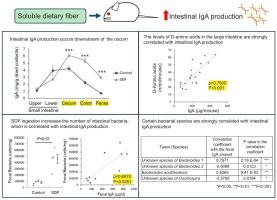肠道d -氨基酸含量与摄入可溶性膳食纤维后肠道IgA的产生高度相关
IF 9.8
1区 农林科学
Q1 CHEMISTRY, APPLIED
引用次数: 0
摘要
可溶性膳食纤维(SDF)诱导肠道产生IgA。从机制上讲,这主要是由肠道细菌产生短链脂肪酸(SCFAs)作为SDF的代谢物来解释的。在这里,我们的目的是确定SCFAs以外的因素有助于sdf诱导的肠道IgA产生。在BALB/cA小鼠中,连续9-12 周摄入SDF(占日粮的3% %)可使粪便IgA产量增加4倍。盲肠SCFA总浓度与粪便IgA含量呈显著正相关(ρ = 0.5734,P = 0.0513),盲肠和结肠中IgA诱导性物质d -氨基酸(D-AAs)含量与IgA含量呈显著正相关(ρ = 0.7805,P <; 0.001)。粪便样品的细菌菌群分析显示,某些细菌种类与IgA的产生高度相关。这些发现表明,D-AAs在sdf诱导的肠道IgA产生中起重要作用。本文章由计算机程序翻译,如有差异,请以英文原文为准。


Intestinal D-amino acids content is highly related to intestinal IgA production upon soluble dietary fiber ingestion in mice
Soluble dietary fiber (SDF) induces intestinal IgA production. Mechanistically, this has primarily been explained by intestinal bacteria producing short-chain fatty acids (SCFAs) as metabolites from the SDF. Here, we aimed to identify factors other than SCFAs that contribute to SDF-induced intestinal IgA production. SDF ingestion (3 % of the diet) for 9–12 weeks induced a four-fold increase in fecal IgA production in BALB/cA mice. The total SCFA concentration in the cecum tends to show a positive correlation with fecal IgA content (ρ = 0.5734, P = 0.0513), while the content of D-amino acids (D-AAs), inducers of IgA, in the cecum and colon exhibited a strongly positive correlation with the IgA content (ρ = 0.7805, P < 0.001). Bacterial flora analysis of fecal samples revealed that certain bacterial species were highly correlated with IgA production. These findings suggest that D-AAs play an important role in SDF-induced intestinal IgA production.
求助全文
通过发布文献求助,成功后即可免费获取论文全文。
去求助
来源期刊

Food Chemistry
工程技术-食品科技
CiteScore
16.30
自引率
10.20%
发文量
3130
审稿时长
122 days
期刊介绍:
Food Chemistry publishes original research papers dealing with the advancement of the chemistry and biochemistry of foods or the analytical methods/ approach used. All papers should focus on the novelty of the research carried out.
 求助内容:
求助内容: 应助结果提醒方式:
应助结果提醒方式:


